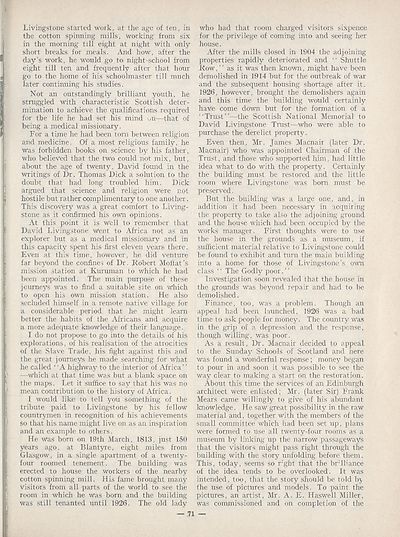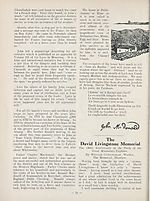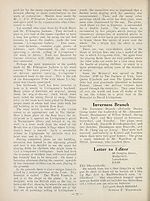An Comunn Gàidhealach Publications > Gaidheal > Volumes 58--62(part), January, 1963--March 1967
(101) Page 71
Download files
Complete book:
Individual page:
Thumbnail gallery: Grid view | List view

Livingstone started work, at the age of ten, in
the cotton spinning mills, working from six
in the morning till eight at night with only
short breaks for meals. And how, after the
day’s work, he would go to night-school from
eight till ten and frequently after that hour
go to the home of his schoolmaster till much
later continuing his studies.
Not an outstandingly brilliant youth, he
struggled with characteristic Scottish deter¬
mination to achieve the qualifications required
for the life he had set his mind wn^—that of
being a medical missionary.
For a time he had been torn between religion
and medicine. Of a most religious family, he
was forbidden books on science by his father,
who believed that the two could not mix, but,
about the age of twenty, David found in the
writings of Dr. Thomas Dick a solution to the
doubt that had long troubled him. Dick
argued that science and religion were not
hostile but rather complimentary to one another.
This discovery was a great comfort to Living¬
stone as it confirmed his own opinions.
At this point it is well to remember that
David Livingstone went to Africa not as an
explorer but as a medical missionary and in
this capacity spent his first eleven years there.
Even at this time, however, he did venture
far beyond the confines of Dr. Robert Moffat’s
mission station at Kuruman to which he had
been appointed. The main purpose of these
journeys was to find a suitable site on which
to open his own mission station. He also
secluded himself in a remote native village for
a considerable period that he might learn
better the habits of the Africans and acquire
a more adequate knowledge of their language.
I do not propose to go into the details of his
explorations, of his realisation of the atrocities
of the Slave Trade, his fight against this and
the great journeys he made searching for what
he called ‘‘A highway to the interior of Africa”
•—which at that time was but a blank space on
the maps. Let it suffice to say that his was no
mean contribution to the history of Africa.
I would like to tell you something of the
tribute paid to Livingstone by his fellow
countrymen in recognition of his achievements
so that his name might live on as an inspiration
and an example to others.
He Was born on 19th March, 1813, just 150
years ago, at Blantyre, eight miles from
Glasgow, in a single apartment of a twenty-
four roomed tenement. The building was
erected to house the workers of the nearby
cotton spinning mill. His fame brought many
visitors from all parts of the world to see the
room in which he Was born and the building
was still tenanted until 1926. The old lady
who had that room charged visitors sixpence
for the privilege of coming into and seeing her
house.
After the mills closed in 1904 the adjoining
properties rapidly deteriorated and “ Shuttle
Row,” as it was then known, might have been
demolished in 1914 but for the outbreak of war
and the subsequent housing shortage after it.
1926, however, brought the demolishers again
and this time the building would certainly
have come down but for the formation of a
“Trust”—the Scottish National Memorial to
David Livingstone Trust—who were able to
purchase the derelict property.
Even then, Mr. James Macnair (later Dr.
Macnair) who Was appointed Chairman of the
Trust, and those who supported him, had little
idea what to do with the property. Certainly
the building must be restored and the little
room where Livingstone was bom must be
preserved.
But the building Was a large one, and, in
addition it had been necessary in acquiring
the property to take also the adjoining ground
and the house which had been occupied by the
works manager. First thoughts were to use
the house in the grounds as a museum, if
sufficient material relative to Livingstone could
be found to exhibit and turn the main building
into a home for those of Livingstone’s own
class ‘ ‘ The Godly poor. ’ ’
Investigation soon revealed that the house in
the grounds Was beyond repair and had to be
demolished.
Finance, too, was a problem. Though an
appeal had been launched, 1926 was a bad
time to ask people for money. The country Was
in the grip of a depression and the response,
though willing, was poor.
As a result, Dr. Macnair decided to appeal
to the Sunday Schools of Scotland and here
was found a Wonderful response; money began
to pour in and soon it was possible to see the
way clear to making a start on the restoration.
About this time the services of an Edinburgh
architect were enlisted; Mr. (later Sir) Frank
Mears came willingly to give of his abundant
knowledge. He saw great possibility in the raw
material and, together with the members of the
small committee which had been set up, plans
were formed to use all twenty-four rooms as a
museum by linking up the narrow passageways
that the visitors might pass right through the
building with the story unfolding before them.
This, today, seems so rght that the brlliance
of the idea tends to be overlooked. It was
intended, too, that the story should be told bj,
the use of pictures and models. To paint the
pictures, an artist, Mr. A. E. Haswell Miller,
was commissioned and on completion of the
— 71 —
the cotton spinning mills, working from six
in the morning till eight at night with only
short breaks for meals. And how, after the
day’s work, he would go to night-school from
eight till ten and frequently after that hour
go to the home of his schoolmaster till much
later continuing his studies.
Not an outstandingly brilliant youth, he
struggled with characteristic Scottish deter¬
mination to achieve the qualifications required
for the life he had set his mind wn^—that of
being a medical missionary.
For a time he had been torn between religion
and medicine. Of a most religious family, he
was forbidden books on science by his father,
who believed that the two could not mix, but,
about the age of twenty, David found in the
writings of Dr. Thomas Dick a solution to the
doubt that had long troubled him. Dick
argued that science and religion were not
hostile but rather complimentary to one another.
This discovery was a great comfort to Living¬
stone as it confirmed his own opinions.
At this point it is well to remember that
David Livingstone went to Africa not as an
explorer but as a medical missionary and in
this capacity spent his first eleven years there.
Even at this time, however, he did venture
far beyond the confines of Dr. Robert Moffat’s
mission station at Kuruman to which he had
been appointed. The main purpose of these
journeys was to find a suitable site on which
to open his own mission station. He also
secluded himself in a remote native village for
a considerable period that he might learn
better the habits of the Africans and acquire
a more adequate knowledge of their language.
I do not propose to go into the details of his
explorations, of his realisation of the atrocities
of the Slave Trade, his fight against this and
the great journeys he made searching for what
he called ‘‘A highway to the interior of Africa”
•—which at that time was but a blank space on
the maps. Let it suffice to say that his was no
mean contribution to the history of Africa.
I would like to tell you something of the
tribute paid to Livingstone by his fellow
countrymen in recognition of his achievements
so that his name might live on as an inspiration
and an example to others.
He Was born on 19th March, 1813, just 150
years ago, at Blantyre, eight miles from
Glasgow, in a single apartment of a twenty-
four roomed tenement. The building was
erected to house the workers of the nearby
cotton spinning mill. His fame brought many
visitors from all parts of the world to see the
room in which he Was born and the building
was still tenanted until 1926. The old lady
who had that room charged visitors sixpence
for the privilege of coming into and seeing her
house.
After the mills closed in 1904 the adjoining
properties rapidly deteriorated and “ Shuttle
Row,” as it was then known, might have been
demolished in 1914 but for the outbreak of war
and the subsequent housing shortage after it.
1926, however, brought the demolishers again
and this time the building would certainly
have come down but for the formation of a
“Trust”—the Scottish National Memorial to
David Livingstone Trust—who were able to
purchase the derelict property.
Even then, Mr. James Macnair (later Dr.
Macnair) who Was appointed Chairman of the
Trust, and those who supported him, had little
idea what to do with the property. Certainly
the building must be restored and the little
room where Livingstone was bom must be
preserved.
But the building Was a large one, and, in
addition it had been necessary in acquiring
the property to take also the adjoining ground
and the house which had been occupied by the
works manager. First thoughts were to use
the house in the grounds as a museum, if
sufficient material relative to Livingstone could
be found to exhibit and turn the main building
into a home for those of Livingstone’s own
class ‘ ‘ The Godly poor. ’ ’
Investigation soon revealed that the house in
the grounds Was beyond repair and had to be
demolished.
Finance, too, was a problem. Though an
appeal had been launched, 1926 was a bad
time to ask people for money. The country Was
in the grip of a depression and the response,
though willing, was poor.
As a result, Dr. Macnair decided to appeal
to the Sunday Schools of Scotland and here
was found a Wonderful response; money began
to pour in and soon it was possible to see the
way clear to making a start on the restoration.
About this time the services of an Edinburgh
architect were enlisted; Mr. (later Sir) Frank
Mears came willingly to give of his abundant
knowledge. He saw great possibility in the raw
material and, together with the members of the
small committee which had been set up, plans
were formed to use all twenty-four rooms as a
museum by linking up the narrow passageways
that the visitors might pass right through the
building with the story unfolding before them.
This, today, seems so rght that the brlliance
of the idea tends to be overlooked. It was
intended, too, that the story should be told bj,
the use of pictures and models. To paint the
pictures, an artist, Mr. A. E. Haswell Miller,
was commissioned and on completion of the
— 71 —
Set display mode to:
![]() Universal Viewer |
Universal Viewer | ![]() Mirador |
Large image | Transcription
Mirador |
Large image | Transcription
| An Comunn Gàidhealach > An Comunn Gàidhealach Publications > Gaidheal > Volumes 58--62(part), January, 1963--March 1967 > (101) Page 71 |
|---|
| Permanent URL | https://digital.nls.uk/127149993 |
|---|
| Description | This contains items published by An Comunn, which are not specifically Mòd-related. It includes journals, annual reports and corporate documents, policy statements, educational resources and published plays and literature. It is arranged alphabetically by title. |
|---|
| Description | A collection of over 400 items published by An Comunn Gàidhealach, the organisation which promotes Gaelic language and culture and organises the Royal National Mòd. Dating from 1891 up to the present day, the collection includes journals and newspapers, annual reports, educational materials, national Mòd programmes, published Mòd literature and music. |
|---|---|
| Additional NLS resources: |
|

